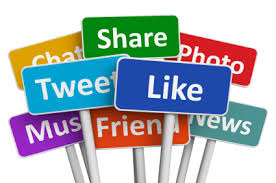This week I thought I would talk about Social Media “myths”. Words of wisdom in social communication that have been repeated so many times they become what people believe. However, they are also the same words that make you stop and question them.
When I worked in radio there were similar myths, mantras that had been trotted out by more experienced people for so long that as a newcomer you just accepted them, even though none of them had any basis in fact.
For example:-
- Female listeners don’t like female presenters
- Never play more than three female voices in a row
- Always put in an hour’s prep for each hour on air.
- Mentioning another radio station will make your listener immediately tune to it.
I could go on – as a young presenter I heard all these and just accepted them. As you gain confidence and experience in your profession you start to question these “myths”.
The same is true of Social Media; here are 10 Myths of the social age to question.
1) I SHOULD BE ON EVERY PLATFORM

Do you know how many social platforms there are? No me neither. One of the basic pitfalls of using Social Media is to try and maintain a presence on lots of platforms, see nothing happen and give up. The first step for every business or organisation is to identify the platforms that will work best for them and concentrate your efforts there.
2) I’LL JUST USE ONE PLATFORM
Just as spreading yourself too thin is not good, the opposite is equally as bad. By all means note the platform that gives you the most traction and make that your primary outlet, but remember that other sites can be complementary. Using a handful of social platforms also gives you the opportunity to cross-promote and link them together.
3) I CAN’T LINK TO MY OTHER SOCIAL PLATFORMS
You have a Facebook account, it’s doing fine, lots of engagement for your excellent content. So you set up a Twitter account as a complementary outlet and because your business is visual you think a Pinterest board would be good too. All excellent ideas. The problem is, you’ve read a few “experts” say you can’t link to them from your Facebook wall because………..well I don’t know why really.
It makes no sense to me. Just do it. The great thing about social is that you can tie up your social channels, your company website, your YouTube channel in a lovely chain of gorgeous digital content.
4) WALL-TO-WALL CONTENT

It’s quality not quantity, less is more etc. etc. Think about what you have to offer and the best way of saying it. What are your keywords, your important messages, how can you encourage your followers to share your content. Of course sell yourself and your services but do it strategically amongst your other posts. Make your channels ones your followers can rely on to be informed and entertained.
5) RE-POSTING
This is one of my bugbears. Someone once said you should never re-post content and it was taken as read. I still see some practitioners espouse this point of view.
I use the analogy of your wife or girlfriend who won’t wear a dress she’s worn before, even though there’ll be no-one at the event who will have seen it the first time.
There is absolutely nothing wrong with re-posting content. We would love all of our content to be seen by all of our social communities, but in the real world that’s never gonna happen.
Do it sensibly and creatively, choose carefully the content you recycle, make sure it’s still relevant when you re-post.
6) DON’T BE PERSONAL
Hang on, isn’t this what being “social” is all about. Of course keep your audience and your customers in mind but don’t be afraid to show off your business/brand’s personality. If it didn’t have one before your social channels give you the chance to create one. It’s 1-2-1 communication, it’s personal, it’s dialogue between you and the person looking at their screen.
7) IT’S A NUMBERS GAME

People still get hung up on numbers; obsess about how many likes, followers and friends they’re notching up. You’ll see people following you then unfollow a few days later when you haven’t reciprocated. You don’t want them anyway.
The sorts of fans and followers you need are ones who will find your content interesting, informative or entertaining enough to share with their own tribes. They could be your flag-wavers and brand ambassadors. 500 people who engage with your posts on a regular basis are far more important to your business than 10,000 people who clicked the “like” button once.
8) IF IT’S NEGATIVE FEEDBACK, IGNORE IT
No-one likes seeing negative stuff written about their business or organisation but the worst thing you can do is ignore or delete it. It’s important to have a plan in place when the situation arises so your response is timely and constructive. Remember anyone who sees the negative comment will also see your way in which you have handed it.
9) SOCIAL IS TOO INFORMAL FOR BUSINESS
I heard this at a networking event just the other week, what the comment says to me is that the person saying it doesn’t know what social media is all about. Social communication is for everyone, irrespective of business type, it can change perceptions of your business in a post or a tweet. When the CIA fired up their Twitter account they got it absolutely right with their first tweet.

10) EVERY POST NEEDS A HASHTAG
#Saving #the #best #for #last. #Dear #Lord #above, #save #us from #Hashtag #Hell.
Hashtags are great, they tie up events, topics, opinions and conversations beautifully but they are the source of more social evil than almost anything else (with serial re-tweeters a close second). They are not however, compulsory and will not guarantee you a trending topic but used carefully and creatively will help those following the hashtag to find your content.
I hope that if you’ve comes across any of those Social Media myths this blog has given you the confidence to take my advice and ignore them.
There a more of them of course, I have a feeling there may be a part 2 coming soon.
51.518944
-3.261053






















